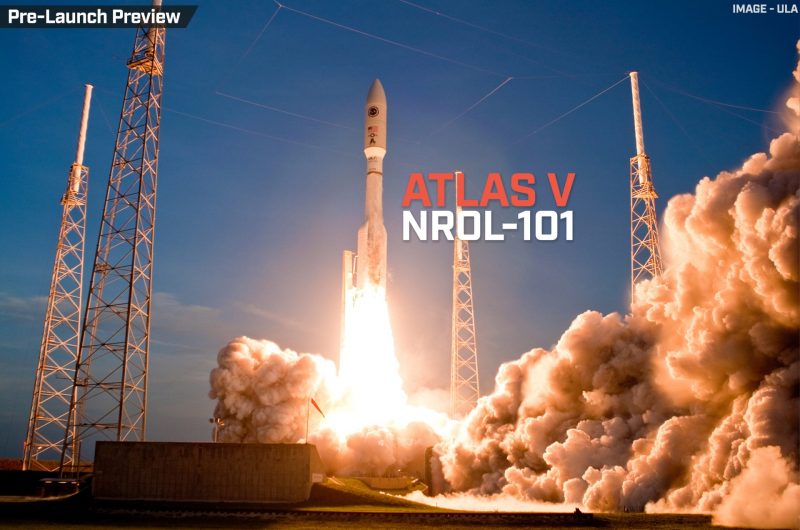LIFT OFF TIME(SUBJECT TO CHANGE) |
November 13, 2020 22:32 UTC | 5:32 PM EST |
|---|---|
MISSION NAME AND WHAT IT IS |
NROL-101, a mission for the National Reconnaissance Office (NRO) |
LAUNCH PROVIDER(WHAT ROCKET COMPANY IS LAUNCHING IT?) |
United Launch Alliance (ULA) |
CUSTOMER(WHO’S PAYING FOR THIS?) |
National Reconnaissance Office (NRO) |
ROCKET |
Atlas V 531 |
LAUNCH LOCATION |
SLC-41, Cape Canaveral AFS, Florida, USA |
PAYLOAD MASS |
Not disclosed, but max payload to GTO is 7,450 kg (~16,420 lbs) |
WHERE ARE THE SATELLITES GOING? |
Molniya Orbit |
HOW’S THE WEATHER LOOKING? |
The weather is currently 80% percent go for launch (as of November 11, 15:00 UTC) |
WILL THEY BE ATTEMPTING TO RECOVER THE FIRST STAGE? |
No, this is not a capability of ULA |
WHERE WILL THE FIRST STAGE LAND? |
It will crash into the Atlantic Ocean |
WILL THEY BE ATTEMPTING TO RECOVER THE FAIRINGS? |
No, this is not a capability of ULA |
ARE THESE FAIRINGS NEW? |
Yes |
THIS WILL BE THE: |
– 1st launch of the GEM63 SRBs – 141st all-time mission for ULA – 86th launch of an Atlas V |
WHERE TO WATCH |
ULA Livestream
Tim Dodd, the Everyday Astronaut, will be streaming at T-30 minutes; come ask questions and join the conversation live! |

What’s this all mean?
Yet again, the trusty launch provider United Launch Alliance (ULA) will use an Atlas V rocket in the 531 configuration to support and deliver a payload for the National Reconnaissance Office (NRO) – NROL-101. Atlas V is scheduled to liftoff from Space Launch Complex 41 (SLC-41) located in Cape Canaveral Air Force Station, Florida, USA.
What is the NROL-101 Mission?
As other National Reconnaissance Missions are, the public, and even some members of ULA, are kept out of the loop about the payload. Government satellites are mostly highly classified due to their technologically advanced nature. The United States government aims to keep this information within the United States as it is highly valuable to world success.
What is the Atlas V?
NROL-101 will launch on the powerful Atlas V rocket in the 531 configuration. It can carry up to 15,530 kg (~34,240 lbs) to Low Earth Orbit and 7,450 kg (~16,420 lbs) to Geostationary Transfer Orbit.
The Atlas V Common Cores are manufactured near Decatur, Alabama and then transported via the Mississippi river and the Gulf of Mexico to either California or Florida aboard the R/S Rocket Ship.
What does 531 Mean?
The configuration of the Atlas V for NROL-101 is 531. The last three numbers or letters in the Atlas V’s name denote the configuration of the rocket. First, the number or letter shows the fairing diameter size (in meters) or ‘N’ for no fairing. In this case the number 5 obviously stands for a 5 meter fairing.
The second number determines the number of strap on solid rocket boosters (SRBs). It can range from 0 to 5, and in this case, there are three SRBs strapped onto the center core. This launch will mark the first time that ULAs new GEM63 SRBs fly as part of the validation process. A variant of these boosters, the bigger GEM63XL, will fly on their upcoming Vulcan rocket.
The third and final number refers to the number of engines on the Centaur Upper Stage, which can be either one or two. In this case there will be one Aerojet Rocketdyne RL-10C engine. The only time that there have been two engines (while on an Atlas V) was on Starliner’s OFT-1 (as of the date of this article).
To summarize, for NROL-101 mission, this rocket has a five-meter fairing, three solid rocket boosters, and one RL-10C engine on the Centaur Upper Stage.







The 45th spacewing has already released the Launch Hazard Area which shows the rocket will be launching towards a ± 56 degree inclination. Given this inclination / azimuth, it will be very unlikely that the satellite(s) will be launched to GEO. Because no reentry area has been issued for the Centaur upper stage, it probably won’t be a LEO mission. The NRO also hasn’t used HEO or MEO orbits (so far we know) before. This means it will be likely that the satellite(s) will go to a Molniya orbit. (Which has been used by the NRO before)
A Molniya orbit is a HEO…
Love your work Austin
keep it up
This is the ULA Stream for NROL-101
https://youtu.be/aynKNh6cvnI
Thanks, I’ve updated the link!
What’s the payload?
Nobody except for ULA and the NRO knows
Awesome 🙂